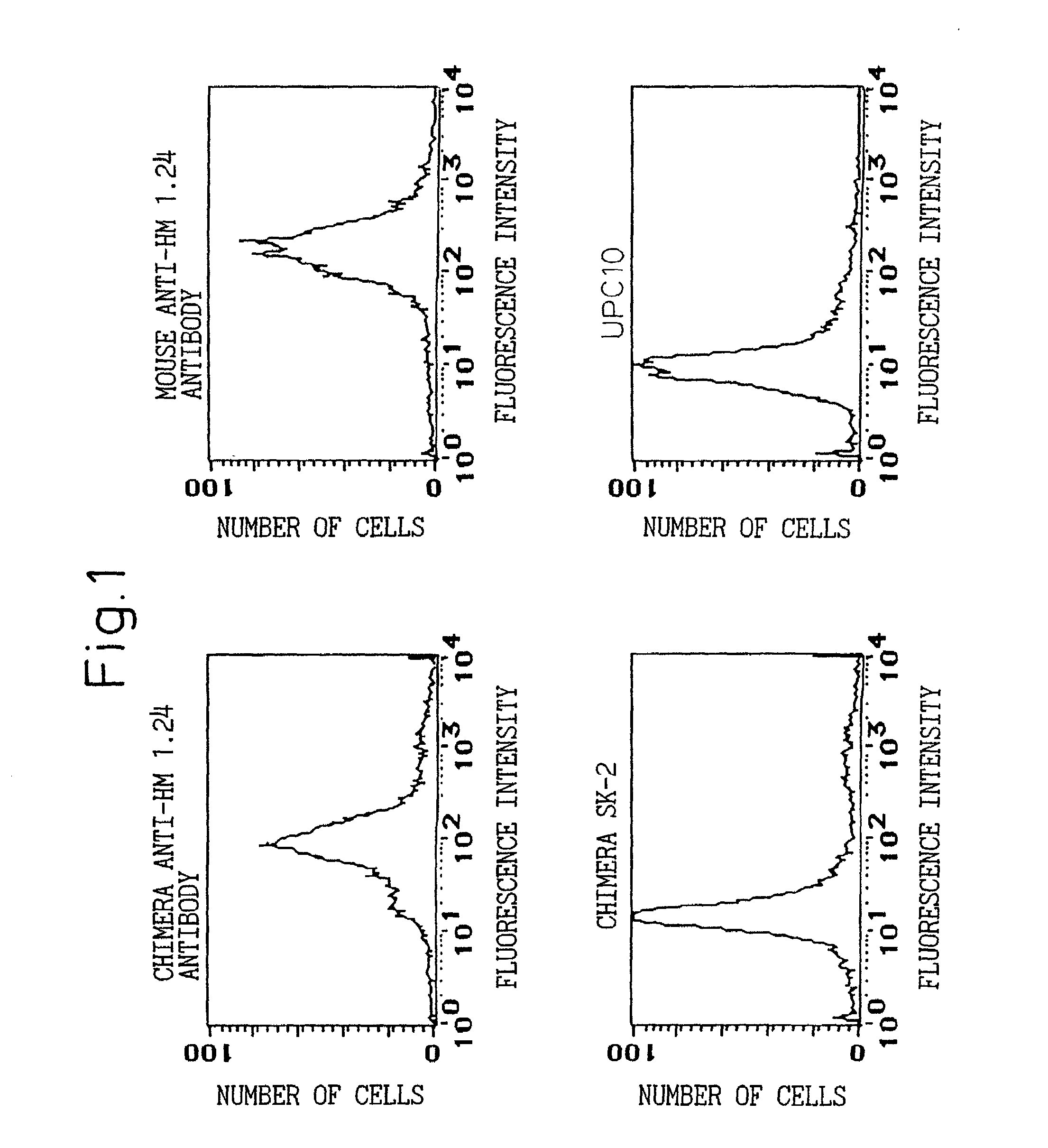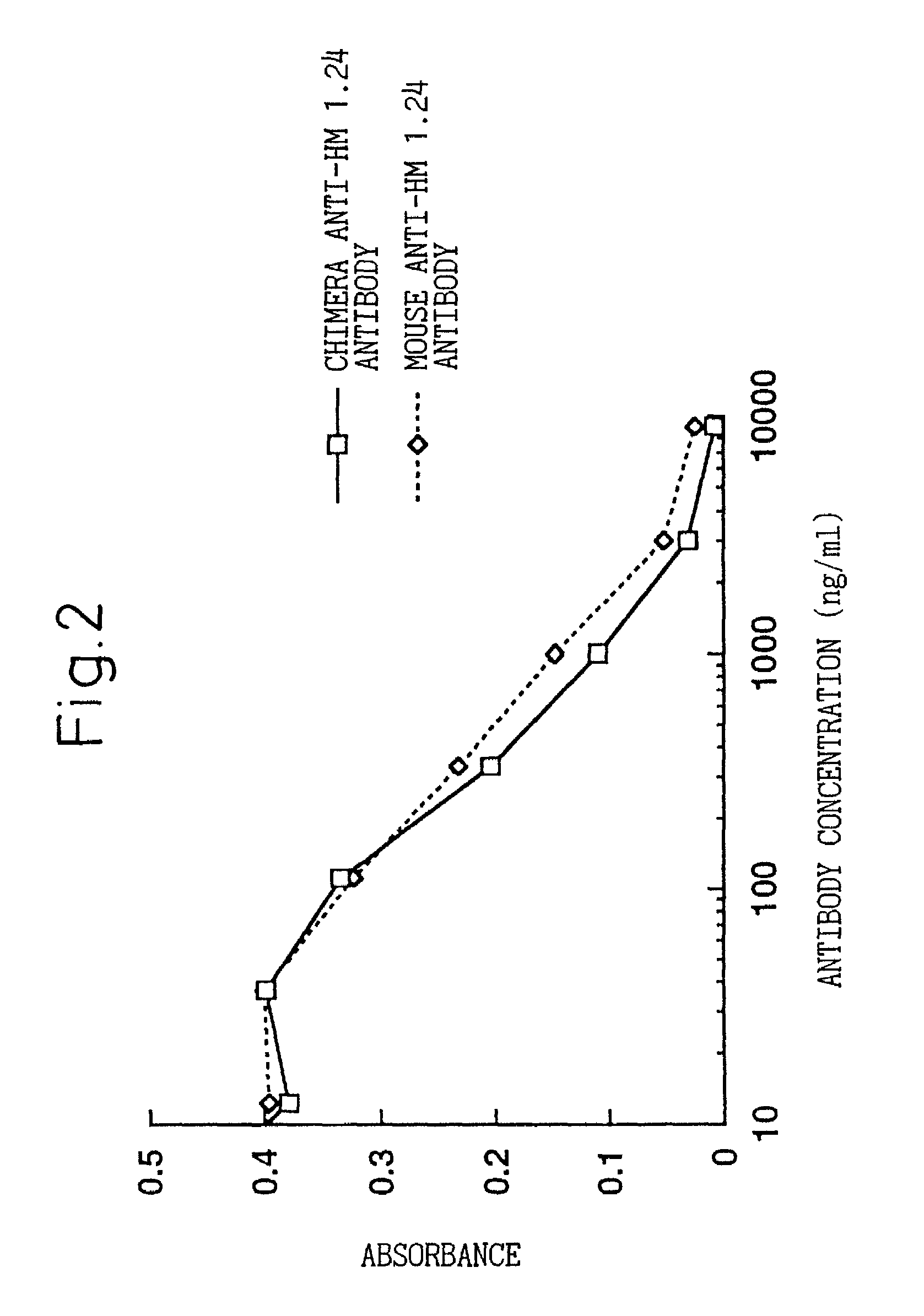Natural human antibody
a humanized antibody and humanization technology, applied in the field of humanized antibody preparation, can solve the problems of antigenicity, unsuitable clinical applications, and inability to provide humanized antibodies that have antigen binding activity,
- Summary
- Abstract
- Description
- Claims
- Application Information
AI Technical Summary
Benefits of technology
Problems solved by technology
Method used
Image
Examples
reference example 1
Cloning of cDNA Encoding the Variable Region of a Mouse Anti-HM1.24 Antibody
[0115]1. Isolation of Messenger RNA (mRNA)
[0116]Using the Fast Track mRNA Isolation Kit Version 3.2 (manufactured by Invitrogen) according to the instruction attached thereto, mRNA was isolated from 2×108 hybridoma cells (FERM BP-5233) that produce a mouse anti-HM1.24 antibody.
[0117]2. Amplification of the Gene Encoding the Variable Region of Antibody by the PCR Method
[0118]PCR was carried out using the amplification Thermal Cycler (manufactured by Perkin Elmer Cetus).
[0119]2-1. Amplification and Fragmentation of the Gene Encoding the V Region of a Mouse L Chain
[0120]From the mRNA thus isolated, single stranded cDNA was synthesized using the AMV Reverse Transcriptase First-strand cDNA Synthesis Kit (manufactured by Life Science) and used for PCR. As primers used for PCR, MKV (Mouse Kappa Variable) primers (Jones, S. T. et al, Bio / Technology, 9, 88–89, (1991)) shown in SEQ ID NO: 29 to 39 that hybridize with ...
reference example 2
Determination of the Nucleotide Sequence of DNA
[0129]The nucleotide sequence of the cDNA coding region in the above-mentioned plasmid was determined using the automatic DNA sequencer (manufactured by Applied Biosystem Inc.) and Taq Dye Deoxy Terminator Cycle Sequencing Kit (manufactured by Applied Biosystem Inc.) in the protocol indicated by the manufacturer.
[0130]The nucleotide sequence of the gene encoding the V region of the L chain of the mouse anti-HM1.24 antibody contained in the plasmid pUCHMVL9 is shown in SEQ ID NO: 1. The nucleotide sequence of the gene encoding the V region of the H chain of the mouse anti-HM1.24 antibody contained in the plasmid pUCHMVHR16 is shown in SEQ ID NO: 3.
reference example 3
Determination of CDR
[0131]The overall structures of the V regions of an L chain and an H chain have a similarity with each other in which four framework portions are linked by three hypervariable regions, i.e. complementarity determining regions (CDR). The amino acid sequence of the framework is relatively well conserved but variation in the amino acid sequence is extremely high (Kabat, E. A., et al., “Sequences of Proteins of Immunological Interest”, US Dept. Health and Human Services, 1983).
[0132]Based on these facts, the amino acid sequence of the variable region of the anti-HM1.24 antibody was fitted to the database of the amino acid sequences of antibodies to investigate homology, and the CDR region was determined as shown in Table 1.
[0133]
TABLE 1PlasmidSequence No.CDR(1)CDR(2)CDR(3)pUCHMVL95 to 7 24–3450–5689–97 pUCHMVHR168 to 1031–3550–6699–109
PUM
| Property | Measurement | Unit |
|---|---|---|
| pH | aaaaa | aaaaa |
| temperature | aaaaa | aaaaa |
| temperature | aaaaa | aaaaa |
Abstract
Description
Claims
Application Information
 Login to View More
Login to View More - R&D
- Intellectual Property
- Life Sciences
- Materials
- Tech Scout
- Unparalleled Data Quality
- Higher Quality Content
- 60% Fewer Hallucinations
Browse by: Latest US Patents, China's latest patents, Technical Efficacy Thesaurus, Application Domain, Technology Topic, Popular Technical Reports.
© 2025 PatSnap. All rights reserved.Legal|Privacy policy|Modern Slavery Act Transparency Statement|Sitemap|About US| Contact US: help@patsnap.com



